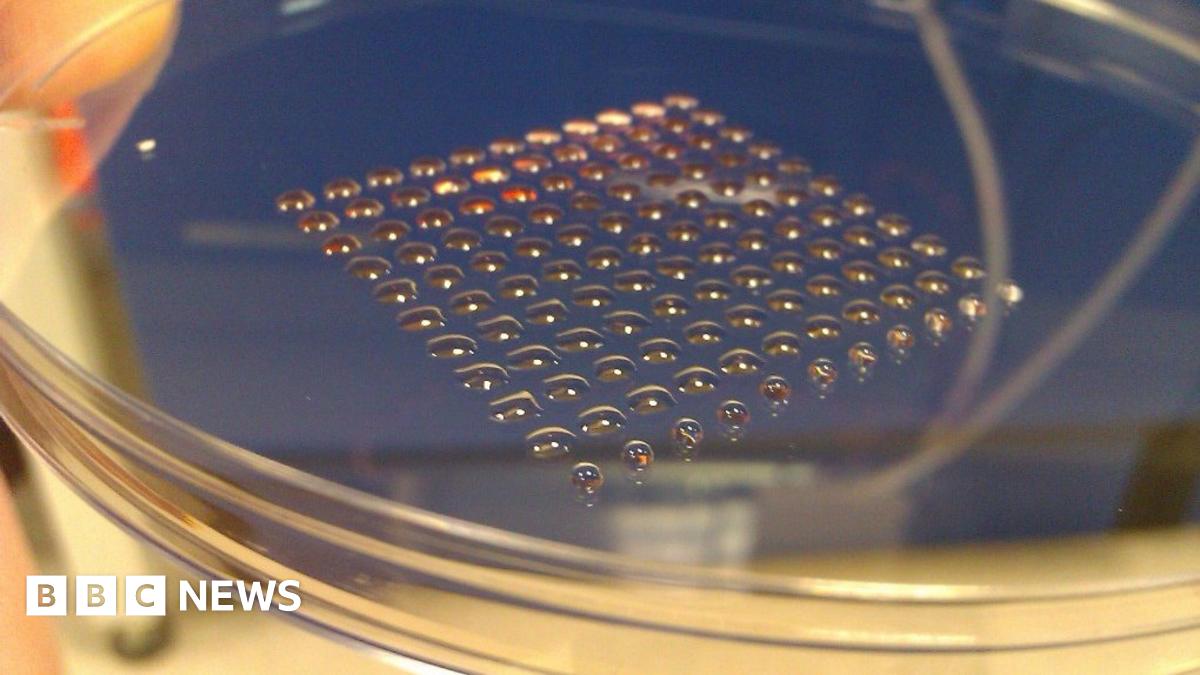Why 3D-Printing an Untraceable Ghost Gun Is Easier Than Ever (Podcast 18mins)
-
On today’s episode of Uncanny Valley, we discuss how WIRED was able to legally 3D-print the same gun allegedly used by Luigi Mangione, and where US law stands on the technology.

Why 3D-Printing an Untraceable Ghost Gun Is Easier Than Ever
On today’s episode of ‘Uncanny Valley,’ we discuss how WIRED was able to legally 3D-print the same gun allegedly used by Luigi Mangione, and where US law stands on the technology.
WIRED (www.wired.com)
-
On today’s episode of Uncanny Valley, we discuss how WIRED was able to legally 3D-print the same gun allegedly used by Luigi Mangione, and where US law stands on the technology.

Why 3D-Printing an Untraceable Ghost Gun Is Easier Than Ever
On today’s episode of ‘Uncanny Valley,’ we discuss how WIRED was able to legally 3D-print the same gun allegedly used by Luigi Mangione, and where US law stands on the technology.
WIRED (www.wired.com)
tl;dr printers got cheaper
-
On today’s episode of Uncanny Valley, we discuss how WIRED was able to legally 3D-print the same gun allegedly used by Luigi Mangione, and where US law stands on the technology.

Why 3D-Printing an Untraceable Ghost Gun Is Easier Than Ever
On today’s episode of ‘Uncanny Valley,’ we discuss how WIRED was able to legally 3D-print the same gun allegedly used by Luigi Mangione, and where US law stands on the technology.
WIRED (www.wired.com)
No plastic can withstand the pressure and shock from the propulsion of the shot, nor the heat or the friction generated. The 3D printed whatever is a fallacy. The only thing you can print is cute things you can attach to whatever.
-
No plastic can withstand the pressure and shock from the propulsion of the shot, nor the heat or the friction generated. The 3D printed whatever is a fallacy. The only thing you can print is cute things you can attach to whatever.
Uhhhh my friend you can print a 9mm CZ scorpion that shoots as well as the real thing. Same with an MP5. You can find videos of them being tested and shot on the internet. A lot has changed in the past few years with 3D printed guns.
https://youtube.com/watch?v=kucefQ6sYbo there are silly videos too
Of course, they are not 100% plastic, but that's irrelevant. They can be made at home with little effort using a 3D printer and from simple materials anyone can buy at a hardware store, without any registration or serial numbers.
A lot of "real" guns are made from plastic, too, btw
-
tl;dr printers got cheaper
And they wirk with more than plastic. I have had that conversation several times. People honestly think all 3d printers can do is cheap plastic.
-
And they wirk with more than plastic. I have had that conversation several times. People honestly think all 3d printers can do is cheap plastic.
What else do they work with?
-
What else do they work with?
Metals, catbon fiber but I heard thise nozzles wear out fast. One printer i saw used lasers to weld metal powder into shapes layer by layer.
-
Uhhhh my friend you can print a 9mm CZ scorpion that shoots as well as the real thing. Same with an MP5. You can find videos of them being tested and shot on the internet. A lot has changed in the past few years with 3D printed guns.
https://youtube.com/watch?v=kucefQ6sYbo there are silly videos too
Of course, they are not 100% plastic, but that's irrelevant. They can be made at home with little effort using a 3D printer and from simple materials anyone can buy at a hardware store, without any registration or serial numbers.
A lot of "real" guns are made from plastic, too, btw
Only the non critical to function parts can be plastic. IE, the barrel can't be plastic. And you can use literally anything else other than 3D printed stuff.
So why is 3D printed even an issue. Anything... A CNC, scissors, metal, a grinder, wood, springs, screws...can be made part of or be used to make anything else. Making things is not magic and a 3D printer is not magic either.
The highest pressure rated plastic has a Ts or just maybe 28ksi. But with 15% elongation and a really weak modulus. So you can make toys basically.
-
Metals, catbon fiber but I heard thise nozzles wear out fast. One printer i saw used lasers to weld metal powder into shapes layer by layer.
Some mad scientist in Scotland claims to have gotten his printing stem cells. He's trying to figure out how to print replacement organs that have no chance of rejection
-
What else do they work with?
Depends on the type of 3D printer.
Fused Deposition Modeling, the standard "filament" 3D printing everyone thinks about when hearing the word 3D printing prints with plastics - of some sort. All of them,to a certain degree.
There are incredibly sturdy options nowadays, which include carbon fibers, but in the end the adhesions between layers will always be an issue. There are also options to print a cast for a mold and some funny techniques where you print a model with a specialised filament that is half plastic,half metal powder and send it to a company which "burn off" the plastic part, replace it with metal and send you back an (almost as sturdy as a cast) part that is fully metal.
Resin based printing is also a thing but not nearly as sturdy as FDM.
Last but not least there is metal powder based SLS(Selective Laser Sintering), but that does not produce those sturdy parts everyone thinks of, is extremely sensitive/requires a lot of knowledge and lastly money - these printers start around 20k for the better models.
In terms of additive manufacturing people are able to print non load bearing gun parts. Maybe even sturdier than before. And easier. (A 400$ printer nowadays does what a 1300$ printer did a year ago and a 15000$ printer did 15 years ago.
But for everything load/pressure/shock bearing, like a barrel, spring assembly,firing pin,etc. will still need to be from pure metal. So people would still need to improvise these,most important, parts.BUT: There are also self-built CNC machines. MPCNC, etc. are a thing, and more advanced projects for around 2500-3000$ omwards can easily achieve a level of precision on steel that is more than sufficient for an all metal ghost gun and close to what industrial guns makers in WW1, maybe even WW2, achieved.
It's currently really the golden age of home manufacturing.
-
Only the non critical to function parts can be plastic. IE, the barrel can't be plastic. And you can use literally anything else other than 3D printed stuff.
So why is 3D printed even an issue. Anything... A CNC, scissors, metal, a grinder, wood, springs, screws...can be made part of or be used to make anything else. Making things is not magic and a 3D printer is not magic either.
The highest pressure rated plastic has a Ts or just maybe 28ksi. But with 15% elongation and a really weak modulus. So you can make toys basically.
In the United States, only the lower is considered a gun. There's no check needed to buy the barrel or slide components, meaning you can print the lower, preferably from a fiber reinforced material, and just slap the unregulated upper components into it.
-
In the United States, only the lower is considered a gun. There's no check needed to buy the barrel or slide components, meaning you can print the lower, preferably from a fiber reinforced material, and just slap the unregulated upper components into it.
You kidding? I know nothing about these things but that sounds just wrong.
-
Some mad scientist in Scotland claims to have gotten his printing stem cells. He's trying to figure out how to print replacement organs that have no chance of rejection
Link? That sounds dope as fuck
-
You kidding? I know nothing about these things but that sounds just wrong.
Nope, not kidding. the receiver is the component that is registered as a firearm, and the rest of the parts that go in it are unregulated. That's also why you may have heard of "80%" receivers. They're not machined all of the way so they are not considered firearms and the purchaser can then finish the machining and install the parts.
-
Depends on the type of 3D printer.
Fused Deposition Modeling, the standard "filament" 3D printing everyone thinks about when hearing the word 3D printing prints with plastics - of some sort. All of them,to a certain degree.
There are incredibly sturdy options nowadays, which include carbon fibers, but in the end the adhesions between layers will always be an issue. There are also options to print a cast for a mold and some funny techniques where you print a model with a specialised filament that is half plastic,half metal powder and send it to a company which "burn off" the plastic part, replace it with metal and send you back an (almost as sturdy as a cast) part that is fully metal.
Resin based printing is also a thing but not nearly as sturdy as FDM.
Last but not least there is metal powder based SLS(Selective Laser Sintering), but that does not produce those sturdy parts everyone thinks of, is extremely sensitive/requires a lot of knowledge and lastly money - these printers start around 20k for the better models.
In terms of additive manufacturing people are able to print non load bearing gun parts. Maybe even sturdier than before. And easier. (A 400$ printer nowadays does what a 1300$ printer did a year ago and a 15000$ printer did 15 years ago.
But for everything load/pressure/shock bearing, like a barrel, spring assembly,firing pin,etc. will still need to be from pure metal. So people would still need to improvise these,most important, parts.BUT: There are also self-built CNC machines. MPCNC, etc. are a thing, and more advanced projects for around 2500-3000$ omwards can easily achieve a level of precision on steel that is more than sufficient for an all metal ghost gun and close to what industrial guns makers in WW1, maybe even WW2, achieved.
It's currently really the golden age of home manufacturing.
I saw an sls printer make a copy of ironman's suit. It was crazy thin and highly detail pieces. Add some paint abd it look just like the movie.
-
Link? That sounds dope as fuck
Since I saw the original article somewhere around 2010-2016, and am unable to find the original article, here are a few articles that seem to indicate that he might not have been as "mad" as I first indicated.

Strathclyde Pioneering 3D Printing Technology Aims To Replace Animal Testing | Glasgow City Of Science & Innovation
A study which harnesses a pioneering 3D printing technique to create tiny human blood vessel structures could eventually help end the use of animals to test new drugs.
Glasgow City of Science & Innovation (glasgowcityofscienceandinnovation.com)

Scottish develop pioneering 3D bioprinting
Researchers at Scotland's Heriot-Watt University develop a 3D printer that can print human embryonic stem cells, using which three dimensional human organs can be produced
(www.biospectrumasia.com)

Edinburgh scientists use 3D printing to produce stem cells
A 3D printing technique that produces stem cells could speed up progress towards making artificial organs, Edinburgh scientists say.

BBC News (www.bbc.com)
That last article is certainly promising, since if it is possible to print stem cells, then it follows that organ replication, with the right environment providing the correct hormones, should make this technology a viable replacement option for the rich, or the masses once the old prophecies about humanity surviving its stupidity have come to pass in the next couple decades.
-
Depends on the type of 3D printer.
Fused Deposition Modeling, the standard "filament" 3D printing everyone thinks about when hearing the word 3D printing prints with plastics - of some sort. All of them,to a certain degree.
There are incredibly sturdy options nowadays, which include carbon fibers, but in the end the adhesions between layers will always be an issue. There are also options to print a cast for a mold and some funny techniques where you print a model with a specialised filament that is half plastic,half metal powder and send it to a company which "burn off" the plastic part, replace it with metal and send you back an (almost as sturdy as a cast) part that is fully metal.
Resin based printing is also a thing but not nearly as sturdy as FDM.
Last but not least there is metal powder based SLS(Selective Laser Sintering), but that does not produce those sturdy parts everyone thinks of, is extremely sensitive/requires a lot of knowledge and lastly money - these printers start around 20k for the better models.
In terms of additive manufacturing people are able to print non load bearing gun parts. Maybe even sturdier than before. And easier. (A 400$ printer nowadays does what a 1300$ printer did a year ago and a 15000$ printer did 15 years ago.
But for everything load/pressure/shock bearing, like a barrel, spring assembly,firing pin,etc. will still need to be from pure metal. So people would still need to improvise these,most important, parts.BUT: There are also self-built CNC machines. MPCNC, etc. are a thing, and more advanced projects for around 2500-3000$ omwards can easily achieve a level of precision on steel that is more than sufficient for an all metal ghost gun and close to what industrial guns makers in WW1, maybe even WW2, achieved.
It's currently really the golden age of home manufacturing.
I never understood why they never just bundled a bunch of carbon composite front loader barrels with electric ignition along with a laser pointer. No need for any metal nor 3d printing.
-
I never understood why they never just bundled a bunch of carbon composite front loader barrels with electric ignition along with a laser pointer. No need for any metal nor 3d printing.
I really don't think these would withstand the pressure,tbh.
At least as long as you mean 3D printed ones. -
I really don't think these would withstand the pressure,tbh.
At least as long as you mean 3D printed ones.No, just laminated ones. Closed at one end. Easy enough to make or buy. You can even improvise the propellant.






